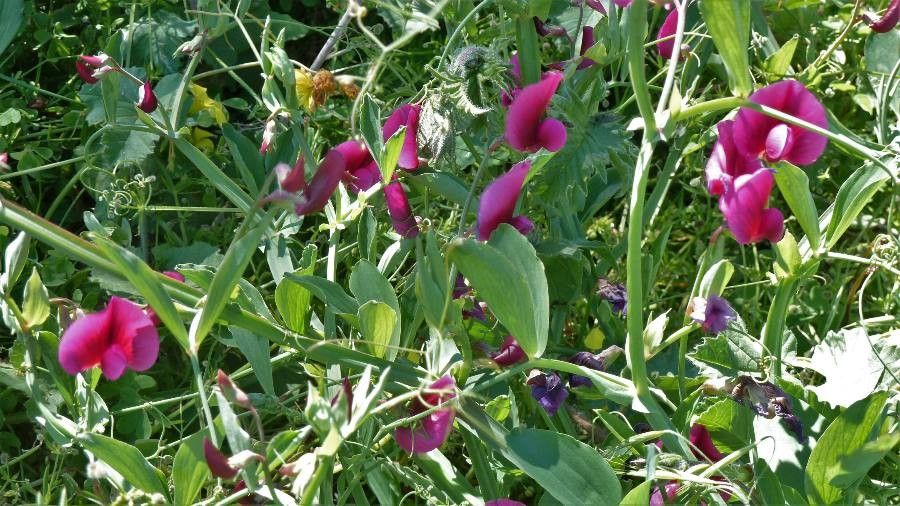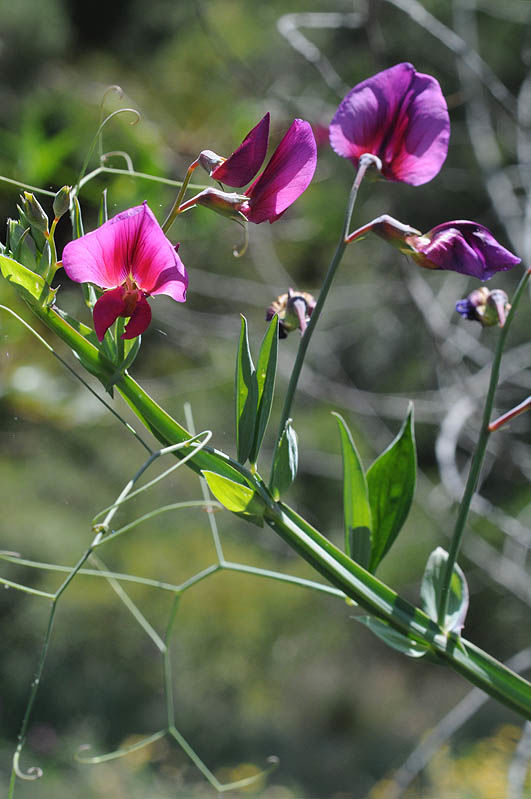Tangier Pea
lathyrus tingitanus
Also known as: ["Tangier Vetchling","Moorish Vetchling"]
Overview
A climbing or trailing legume native to North Africa and the Iberian Peninsula, known for its delicate pinkish-purple flowers and pinnate leaves.
Benefits & Perks
["fragrant flowers","wildlife attractant (bees, butterflies, birds)","drought tolerant"]
Botanical Classification
| Phylum: | Magnoliophyta |
| Class: | Magnoliopsida |
| Order: | Fabales |
| Family: | Fabaceae |
| Genus: | Lathyrus |
| Botanical Name: | Lathyrus tingitanus |
Plant Characteristics
Basic Information
- Category: Flowers
- Suitable Location: garden bed or container in a sunny spot
- Suitable For:
- Is Weed: No
- Allergenicity: low
Environmental Needs
- Climate: {"temperatureRange":"5–30°C"}
- Hardiness: {"zones":"8–10"}
- Misting: rarely required, only if ambient humidity is very low
- Drainage: Fast-draining to prevent waterlogging.
- Soil Type: Well-draining loamy soil with added organic matter.
Maintenance Level
- Maintenance Level: moderate
- Toughness Level: moderate
- Pruning Frequency: Annually after flowering; light pruning as needed.
- Pruning Intensity: Moderate; remove up to one-third of growth if overgrown.
Care Details
Ideal Sunlight Coverage:
Full sun (6–8 hours/day); tolerates partial shade but blooms best in direct light.
Sunlight Tolerance Tips:
Acclimate gradually if moving from shade to sun; protect from intense midday sun in hot climates; ensure good air circulation to prevent mildew.
Care Requirements
Care Difficulty
easymoderate
Sunlight
full sun to partial shade
Rotate plant for even growth; use sheer curtains to filter harsh sun; place near south-facing window for optimal light.
Watering
every 7–10 days during active growth, reduce in winter
Water thoroughly but infrequently; ensure soil dries slightly between waterings; avoid overhead watering to prevent fungal issues.
Soil
well-draining, loamy soil with added organic matter
pH: Slightly acidic to neutral (6.0–7.0).
Use raised beds for better drainage; avoid heavy clay soils; topdress with compost annually.
Temperature
Prefers 60–75°F (15–24°C); can tolerate cooler temperatures but avoid frost.
Avoid sudden temperature changes; keep away from heating/cooling vents; monitor nighttime lows.
Fertilizing
every 4–6 weeks during growing season
Apply fertilizer after watering; stop feeding when plant is dormant; flush soil occasionally to prevent salt buildup.
Propagation
Methods
Stem cuttings or seed sowing.
Step-by-Step Propagation Guide
- Take 4–6 inch cuttings.
- Remove lower leaves.
- Dip in hormone.
- Plant in medium.
- Keep moist and warm.
Best Time: Spring or early summer when plant is actively growing.
Environment
High humidity (70–80%), warm (65–75°F), indirect light.
Medium
Well-draining potting mix with perlite or sand.
Hormone
Optional but recommended for faster rooting.
Timeline
Roots in 2–4 weeks; establish in 8–12 weeks.
Tools Needed
Pruners, rooting hormone, small pots, misting spray bottle.
Quick Tips
Use healthy, non-flowering stems; maintain consistent moisture; provide bottom heat for faster rooting.
Pruning & Repotting
Pruning Guide
Method
Pinch back tips for bushiness; cut back stems to healthy buds.
Pruning Plan
Remove dead or weak growth; shape plant to encourage bushiness; prune after flowering to promote rebloom.
Tools
Pruning shears, clean knife.
Checklist
Sterilize tools; prune dead/damaged growth; shape plant; clean up debris.
Repotting Guide
Best Season
Early spring before new growth begins.
Pot Size
One size larger pot; ensure drainage holes.
Method
Remove plant gently; trim roots if needed; repot in fresh soil with good drainage; water lightly.
Suggestions
Repot every 2–3 years or when roots fill the pot; beneficial for growth and flowering.
Checklist
Check root bound status; prepare new pot; use fresh soil; water after repotting.
Advanced Care Tips
Watering Mastery
Watering Checklist
Check soil moisture; water deeply; ensure drainage; avoid wetting foliage.
How to Apply Water Properly
Water at the base of the plant, ensuring moisture reaches the root zone; water until it drains from the bottom but avoid waterlogging; water in the morning to allow foliage to dry.
Watering Schedule Tips
Water deeply once the top inch of soil feels dry; reduce frequency in winter to prevent root rot.
Soil Improvement
Add perlite or sand for drainage; incorporate compost for fertility; ensure good aeration.
Temperature Stress Management
Signs of Temperature Issues
Yellowing leaves (cold stress); wilting or leaf drop (heat stress).
Cold Stress
Slows growth; may cause leaf discoloration or dieback in prolonged cold.
Solution: Move to a warmer location; provide frost protection if outdoors; avoid cold drafts.
Hot Stress
Leaves may scorch or wilt; flowering may be reduced.
Solution: Provide shade during peak heat; increase watering; use mulch to retain soil moisture.
Fertilizing Guide
Fertilizing Checklist
Check fertilizer type; dilute correctly; apply during active growth; avoid winter feeding.
Fertilizing Method
Use balanced liquid fertilizer diluted to half strength every 4–6 weeks during growing season; avoid fertilizing in winter.
Common Problems & Solutions
Toxicity Warning
Cats
Slightly ToxicCats are susceptible to the toxic amino acids in Lathyrus tingitanus, which can cause gastrointestinal distress and mild neurological effects. Chronic ingestion may lead to more severe neurological complications.
⚠️ Symptoms:
🌿 Toxic Parts:
⚡ Toxic If:
if eaten
Dogs
Slightly ToxicIn dogs, ingestion of Lathyrus tingitanus seeds or young pods can lead to gastrointestinal upset and mild neurological symptoms due to the presence of toxic amino acids. While rare, chronic exposure may contribute to neurolathyrism-like conditions.
⚠️ Symptoms:
🌿 Toxic Parts:
⚡ Toxic If:
if eaten
Humans
Slightly ToxicLathyrus tingitanus contains toxic amino acids that can cause neurolathyrism, a condition characterized by progressive paralysis and muscle weakness. The toxins interfere with neural function and can lead to long-term neurological damage if consumed regularly over time.
⚠️ Symptoms:
🌿 Toxic Parts:
⚡ Toxic If:
if eaten
Frequently Asked Questions
Q: Is Lathyrus tingitanus toxic to pets?
A: It is mildly toxic to dogs and cats if ingested.
Q: Does this plant attract wildlife?
A: Yes, it attracts bees, butterflies, and birds due to its fragrant flowers.
Q: How much maintenance does it require?
A: It has moderate maintenance needs, requiring occasional pruning and watering.
Quick Reference
| Family: | Fabaceae |
| Care: | easy |
| Light: | full sun to partial shade |
| Water: | every 7–10 days during activ |
Get Expert Care Tips
Download the Plantious app for personalized care reminders and plant identification!
Google Play App Store







